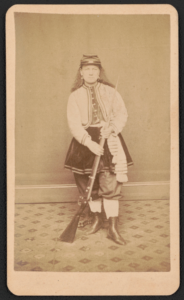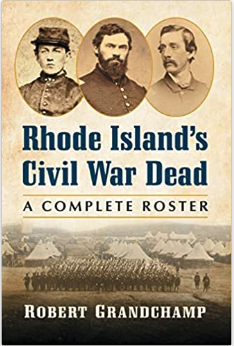While women today serve in front-line duties, it was not an accepted practice in the past. However, in the Civil War, there are some stories, some legitimate and others questionable, about women who donned uniforms and fought beside men on both sides of the battlefields. Countless others contributed by providing nursing care and support services behind the lines.
Vivandieres, as these bold women were known, had a direct connection to active fighting men, most often as daughters of officers. These women, usually in some type of uniform, braved the battlefield and were sometimes armed. Most were not directly involved in combat and many were involved in providing spirits and other comfort items to the troops. Vivandieres originated among the French Zouaves in the Crimean War, and by 1865 had been granted official status in the French military. (Rhode Island briefly had its own colorfully attired Zouave unit, the 10th Rhode island Infantry, organized for nonety days service in 1862. The unit did garrison duty in and around Washington, D.C. between May and September of that year after which time it was mustered out. Unlike its French counterpart, it had no Vivandieres.)
During the Civil War, in keeping with European tradition, many American military units, both Union and Confederate, had one or more women, known as “daughters of the regiment”, among their ranks. But they typically did not get involved in combat.
Although, in 1864, General U.S. Grant banned women from Union military encampments, they continued to go onto the battlefield to care for the wounded and provide care and comfort behind the lines. A few served as spies.
As many as 400 women are believed to have served in armies on both sides of the war and a few were documented as having fought in combat. In many case, they managed to enlist and conceal their identities until they were killed, wounded or caught in some other way. Others made it through the war without being discovered as females. At least one, Mary Wise, who served with the 34th Indiana Regiment, was paid for her service by order of President Abraham Lincoln. Although the actual number of women soldiers is unknown and their contributions received limited formal recognition, their actions are documented in a number of personal histories.
Among eight women who are known to have fought openly as women is a Rhode Islander, Kady Southwell Brownell. Most women fought in male attire, but Kady dressed in her own version of a female uniform. She served under fire with her husband’s units in two Rhode Island regiments, primarily as a color bearer.
Brownell was born in 1842 in South Africa, the daughter of a British Army colonel, George Southwell. Kady’s mother died soon after Kady’s birth and the infant wound up in the care of the McKenzie family, whose members eventually emigrated to and settled in Providence. By 1860, as a seventeen-year-old, she had found work as a weaver in a textile mill in Central Falls. Here, Kady met a man named Robert Brownell. They fell in love, but there was a slight complication. Robert was already married. His wife soon discovered the romance and divorced him. The records are dim regarding whether or Kady and Robert went on to be officially married, but they lived as husband and wife.
When the Civil War broke out, like many young men, Robert volunteered—he volunteered for three months service in the 1st Regiment Rhode Island Volunteer Infantry in April of 1861. Off he went to serve under another (and very well known) Rhode Islander, Colonel (soon to be General) Ambrose Burnside. Kady tried unsuccessfully to follow her husband, but eventually she talked state Governor William Sprague into helping her reunite with him. Colonel Burnside named her a daughter of the regiment and she became a color-bearer for the 1st Rhode Island. She and Robert were together again. (Having taken Robert from Robert’s prior wife, it is a fair question to ask whether she was concerned that another woman might grab Robert’s attention, if she had not been by his side.)
At the First Battle of Bull Run in Virginia Kady became separated from her husband and joined the rout and retreat of Union soldiers back to Washington. There, she and Robert were reunited. They returned to Providence and were mustered out after their tour in August of 1861.
The patriotic Robert volunteered again, this time signing on as an infantryman with the 5th Rhode Island Regiment in December of1862. Guess who went along? Again, Kady and Robert served together.
The regiment fought under the overall command of General Ambrose Burnside in the Battle of New Bern, North Carolina. At first, Kady carried the colors, but she was later ordered to provide nursing care to the wounded. Robert was separated from Kady during one skirmish and he wound up in a Union military hospital. Kady searched for him until the two were reunited. She stayed with him through his recovery. When he went back to Rhode Island eight months later, she was by his side. Both were again mustered out at the same time. This time, Kady received official discharge papers—apparently the only woman to be given this formal documentation by the Union Army.
In his 2013 book, The Hidden History of Rhode Island and the Civil War, author Frank Grzyb traced the Brownells’ story to Connecticut where they settled in Bridgeport. Kady was accepted into the local Grand Army of the Republic post on the basis of her discharge papers. In her later years, she was also granted a government pension ($8.00 a month). She and Robert then moved to, and worked in, New York City. Over the years, the depth of her service was often questioned but enough supporters existed to drown out the nay-sayers. Probably while she was in New York City, several photographs were made of her with rifle in hand, perhaps intended to resell to the public.
Kady lived to the age of seventy-two died at a charity hospital outside New York City in 1915. Her still-living husband managed to scrape together the money to send her body back to Rhode Island where se was laid to rest in the North Burial Ground in Providence.
Surprisingly, Robert had Kady’s body buried in the same plot as his first wife. Given his monetary circumstances, it was probably just common sense. Robert never made it back to Rhode Island to join his two wives. He wound up in an unmarked gravesite in East Harrisburg Cemetery, Pennsylvania, a year after Kady’s passing.
The majority of women during the time of the Civil War patiently waited on the home front for their loved ones, boosting morale with letters and gifts. On the Union side, many raised money and purchased supplies for distribution to the troops under the auspices of the newly formed United States Sanitary Commission. But, as our story shows, a handful of women went the extra mile to fight alongside their men.
[Banner Image: Kady Brownell posing with a rifle, probably in New York City]
Bibliography
Grzyb, Frank L., The Hidden History of Rhode Island and the Civil War (Charleston, SC: History Press, 2013)
Mihalov, Kaitlin, “Vivandieres: Forgotten Women of the Civil War” (August 2008), accessed in the archives at www.army.mil/news
“Rhode Island Unit Regimental Histories,” at www.civilwararchives.com
Smith, Sam, “Female Soldiers in the Civil War”, Civil War Trust. www.civilwar.org
“Women of the Civil War,” Catalog of the United States Capitol Historical Society (Fall 2014)
“Kady Brownell” on Wikipedia, at www.wikipedia.com



























